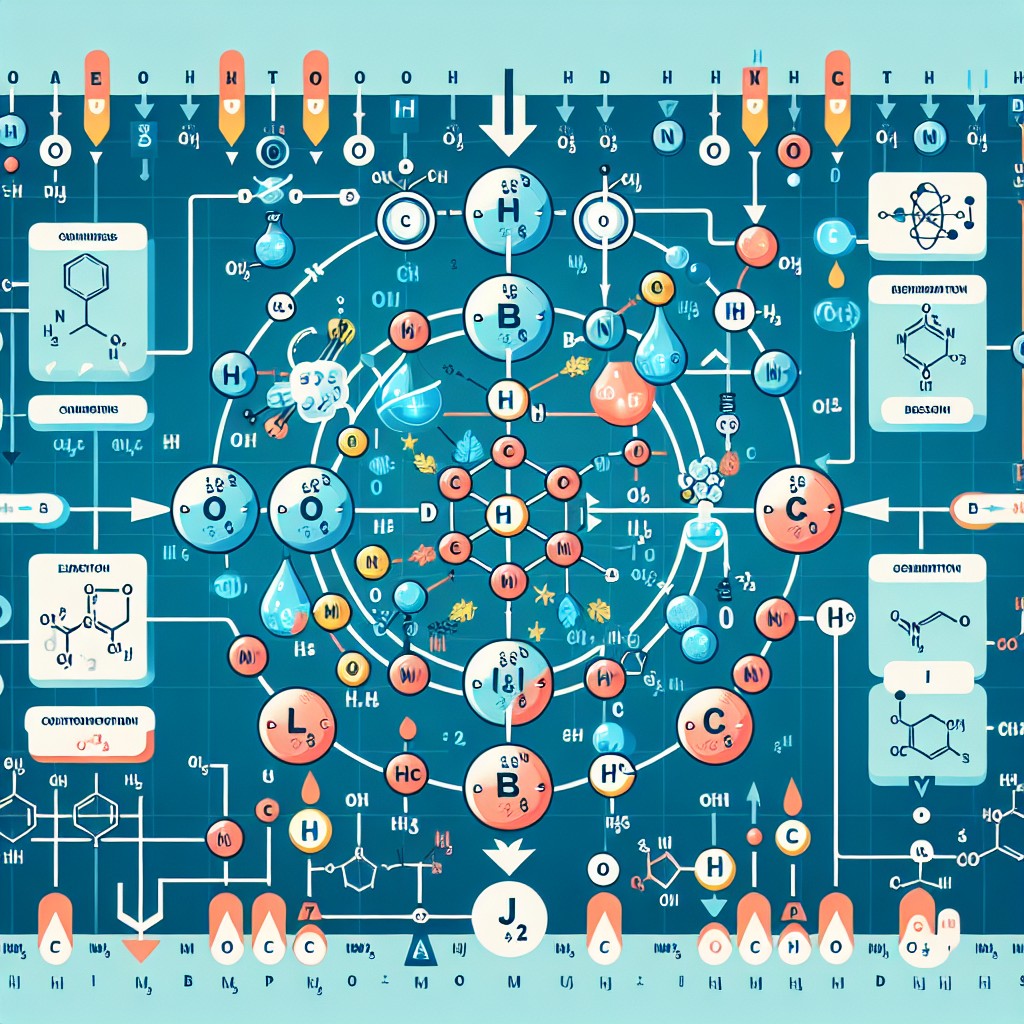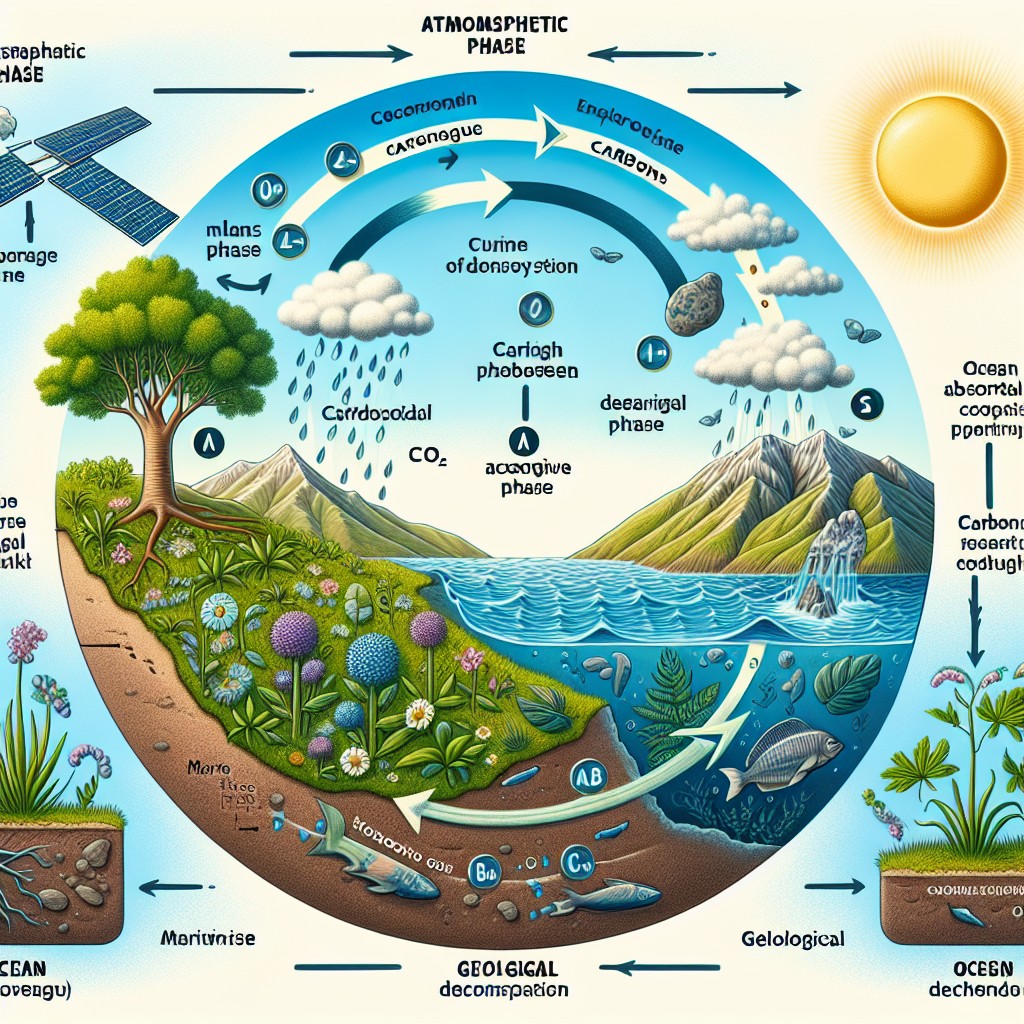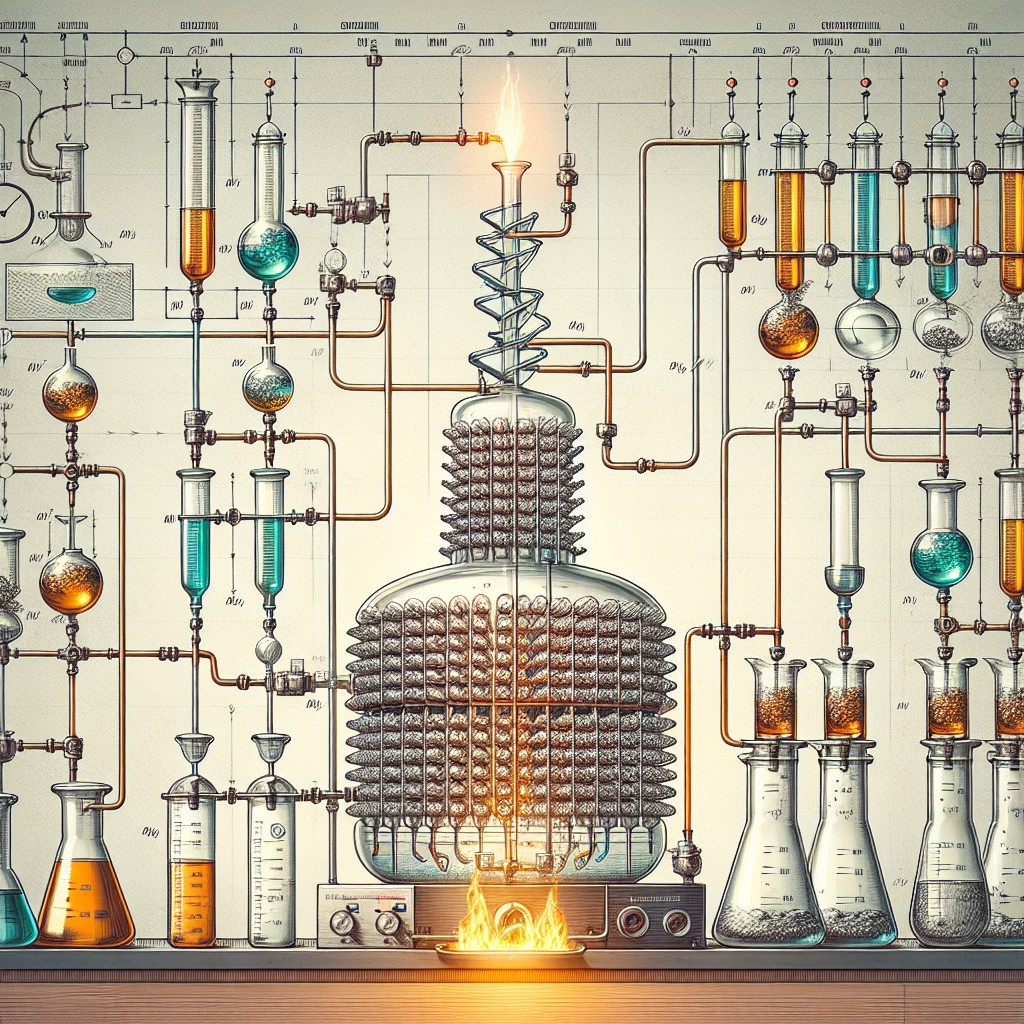Stoichiometry is a fundamental concept in chemistry that plays a crucial role in understanding and predicting chemical reactions. It involves the quantitative relationship between reactants and products in a chemical reaction. By using stoichiometry, chemists can determine the amount of reactants needed to produce a certain amount of product, or vice versa. This information is essential for designing and optimizing chemical processes, as well as for understanding the behavior of substances in various industries and medical applications.
Key Takeaways
- Stoichiometry is the study of the quantitative relationships between reactants and products in chemical reactions.
- Balancing chemical equations involves ensuring that the number of atoms of each element is the same on both sides of the equation.
- There are five main types of chemical reactions: synthesis, decomposition, single replacement, double replacement, and combustion.
- Limiting reactants are the reactants that are completely consumed in a reaction, and their amounts determine the amount of product that can be formed.
- Gas laws, molarity, and redox reactions are all important concepts in stoichiometry that have real-life applications in industry and medicine.
Understanding the Basics of Stoichiometry
Stoichiometry is derived from the Greek words “stoicheion” meaning element, and “metron” meaning measure. It is the calculation of quantitative relationships between reactants and products in a chemical reaction. The mole concept is central to stoichiometry, as it allows chemists to count atoms and molecules on a macroscopic scale. Avogadro’s number, which is approximately 6.022 x 10^23, represents the number of particles (atoms, molecules, ions) in one mole of a substance.
Stoichiometric calculations involve using balanced chemical equations to determine the ratios of reactants and products. A balanced chemical equation shows the relative number of moles of each substance involved in a reaction. For example, the balanced equation for the combustion of methane (CH4) is:
CH4 + 2O2 -> CO2 + 2H2O
This equation tells us that one mole of methane reacts with two moles of oxygen gas to produce one mole of carbon dioxide and two moles of water. Stoichiometric calculations can be used to determine how much methane is needed to produce a certain amount of carbon dioxide, or how much oxygen is required to completely react with a given amount of methane.
Balancing Chemical Equations: Step-by-Step Guide
Chemical equations need to be balanced because atoms are neither created nor destroyed in a chemical reaction. The law of conservation of mass states that the total mass of the reactants must equal the total mass of the products. Balancing a chemical equation involves adjusting the coefficients in front of the chemical formulas to ensure that the number of atoms on both sides of the equation is equal.
A step-by-step guide to balancing chemical equations includes:
1. Write down the unbalanced equation.
2. Count the number of atoms of each element on both sides of the equation.
3. Start by balancing elements that appear in only one compound on each side of the equation.
4. Balance elements that appear in multiple compounds next, using coefficients to adjust the number of atoms.
5. Check that the number of atoms is balanced on both sides of the equation.
6. If necessary, repeat steps 3-5 until the equation is balanced.
Balancing chemical equations is a crucial skill in stoichiometry, as it allows chemists to accurately determine the ratios of reactants and products in a reaction.
Types of Chemical Reactions and Stoichiometry
| Reaction Type | Description | Example |
|---|---|---|
| Combination Reaction | Two or more substances combine to form a single product. | 2H2 + O2 → 2H2O |
| Decomposition Reaction | A single reactant breaks down into two or more products. | 2H2O → 2H2 + O2 |
| Single Displacement Reaction | An element reacts with a compound and displaces another element from the compound. | Zn + 2HCl → ZnCl2 + H2 |
| Double Displacement Reaction | Two compounds exchange ions to form two new compounds. | AgNO3 + NaCl → AgCl + NaNO3 |
| Acid-Base Reaction | An acid reacts with a base to form a salt and water. | HCl + NaOH → NaCl + H2O |
| Stoichiometry | The calculation of the quantities of reactants and products in a chemical reaction. | 2H2 + O2 → 2H2O |
There are several types of chemical reactions, including synthesis, decomposition, combustion, single displacement, double displacement, and acid-base reactions. Stoichiometry can be used to predict the products of these reactions and determine the amounts of reactants needed.
In a synthesis reaction, two or more substances combine to form a single product. For example:
2Na + Cl2 -> 2NaCl
Stoichiometry can be used to determine how much sodium (Na) and chlorine (Cl2) are needed to produce a certain amount of sodium chloride (NaCl).
In a decomposition reaction, a single compound breaks down into two or more simpler substances. For example:
2H2O -> 2H2 + O2
Stoichiometry can be used to determine how much water (H2O) is needed to produce a certain amount of hydrogen gas (H2) and oxygen gas (O2).
In a combustion reaction, a substance reacts with oxygen to produce carbon dioxide and water. For example:
CH4 + 2O2 -> CO2 + 2H2O
Stoichiometry can be used to determine how much methane (CH4) and oxygen (O2) are needed to produce a certain amount of carbon dioxide (CO2) and water (H2O).
Stoichiometry can also be used to predict the products of single displacement, double displacement, and acid-base reactions, as well as determine the amounts of reactants needed.
Limiting Reactants: How to Identify and Solve Problems
In a chemical reaction, the limiting reactant is the substance that is completely consumed and limits the amount of product that can be formed. The excess reactant is the substance that is not completely consumed and is left over after the reaction is complete. Identifying the limiting reactant is important in stoichiometry because it allows chemists to accurately calculate the amount of product that can be formed.
To identify the limiting reactant, one must compare the stoichiometric ratios of the reactants in the balanced chemical equation to the actual amounts of each reactant present. The reactant that produces the least amount of product is the limiting reactant.
Once the limiting reactant has been identified, stoichiometry can be used to calculate the amount of product that can be formed. This involves using the stoichiometric ratio between the limiting reactant and the product in the balanced chemical equation. The amount of product formed can be calculated by multiplying the moles of limiting reactant by the stoichiometric ratio.
Stoichiometry and Gas Laws: Volume, Pressure, and Temperature
Stoichiometry is closely related to gas laws, which describe the behavior of gases in terms of volume, pressure, and temperature. The ideal gas law, PV = nRT, relates the pressure (P), volume (V), number of moles (n), and temperature (T) of a gas.
Stoichiometry can be used to calculate the volume, pressure, and temperature of gases in chemical reactions. This involves using the stoichiometric ratios between reactants and products in the balanced chemical equation, as well as the ideal gas law.
For example, consider the reaction:
2H2 + O2 -> 2H2O
Stoichiometry can be used to determine the amount of water vapor produced from a given amount of hydrogen gas and oxygen gas. The ideal gas law can then be used to calculate the volume, pressure, or temperature of the water vapor.
Molarity and Stoichiometry: Calculating Concentrations and Amounts
Molarity is a measure of the concentration of a solution and is defined as the number of moles of solute per liter of solution. Stoichiometry can be used to calculate the concentration of a solution, as well as the amount of solute needed to make a solution.
To calculate the concentration of a solution using stoichiometry, one must first determine the number of moles of solute and the volume of solution. The molarity can then be calculated by dividing the number of moles by the volume in liters.
To calculate the amount of solute needed to make a solution using stoichiometry, one must first determine the desired volume and molarity of the solution. The number of moles can then be calculated by multiplying the desired volume by the desired molarity.
Redox Reactions and Stoichiometry: Balancing Electron Transfer
Redox reactions involve the transfer of electrons between reactants. Oxidation is the loss of electrons, while reduction is the gain of electrons. Balancing redox reactions using stoichiometry involves balancing both the mass and charge of the reactants and products.
To balance a redox reaction, one must first identify the species that are being oxidized and reduced. The number of electrons transferred must then be balanced by adding appropriate coefficients to the chemical equation. Finally, the mass and charge of the reactants and products must be balanced by adjusting the coefficients.
Stoichiometry is essential in balancing redox reactions, as it allows chemists to accurately determine the ratios of reactants and products involved in electron transfer.
Stoichiometry in Real-Life Applications: Industry and Medicine
Stoichiometry plays a crucial role in various industries and medical applications. In industry, stoichiometry is used to design and optimize chemical processes, determine the amount of raw materials needed, and calculate the yield of a reaction. For example, stoichiometry is used in the production of fertilizers, pharmaceuticals, and polymers.
In medicine, stoichiometry is used to calculate drug dosages, determine the concentration of drugs in a solution, and understand the interactions between drugs and biological systems. For example, stoichiometry is used in pharmacokinetics to study how drugs are absorbed, distributed, metabolized, and excreted by the body.
Stoichiometry is also important in environmental science, as it allows scientists to understand and predict the behavior of pollutants in air, water, and soil. It is used to calculate emission rates, determine the efficiency of pollution control devices, and assess the impact of pollutants on human health and ecosystems.
Common Mistakes in Stoichiometry and How to Avoid Them
There are several common mistakes that students often make when performing stoichiometric calculations. One common mistake is not properly balancing chemical equations before performing calculations. This can lead to incorrect ratios between reactants and products, resulting in inaccurate calculations.
Another common mistake is not converting units properly. Stoichiometric calculations often involve converting between moles, grams, liters, and other units. It is important to use conversion factors and dimensional analysis to ensure that the units cancel out correctly and the final answer has the desired units.
A third common mistake is not using the correct stoichiometric ratio. The stoichiometric ratio is determined by the coefficients in the balanced chemical equation. Using the wrong ratio can lead to incorrect calculations and inaccurate results.
To avoid these mistakes, it is important to carefully read and understand the problem, double-check all calculations and conversions, and practice stoichiometry problems regularly to build proficiency.
Practice Problems and Exercises for Mastering Stoichiometry
To master stoichiometry, it is important to practice solving a variety of problems and exercises. This will help build proficiency in balancing chemical equations, calculating stoichiometric ratios, identifying limiting reactants, and performing other stoichiometric calculations.
Here are some practice problems and exercises for readers to test their understanding of stoichiometry:
1. Balance the following chemical equation: Fe + O2 -> Fe2O3
2. How many moles of water (H2O) are produced when 2 moles of hydrogen gas (H2) react with excess oxygen gas (O2) according to the following balanced equation: 2H2 + O2 -> 2H2O
3. What is the molarity of a solution that contains 0.5 moles of solute in 1 liter of solution?
4. How many grams of sodium chloride (NaCl) are needed to make 500 mL of a 0.1 M solution?
5. Balance the following redox reaction: MnO4- + H+ + C2O4^2- -> Mn^2+ + CO2 + H2O
Stoichiometry is a fundamental concept in chemistry that is essential for understanding and predicting chemical reactions. It involves the quantitative relationship between reactants and products in a chemical reaction and allows chemists to determine the amount of reactants needed to produce a certain amount of product, or vice versa. Stoichiometry is important in various industries and medical applications, as it is used to design and optimize chemical processes, calculate drug dosages, and understand the behavior of substances in environmental systems. By practicing stoichiometry problems and exercises, students can master this important concept and apply it to real-life situations.
FAQs
What is stoichiometry?
Stoichiometry is a branch of chemistry that deals with the quantitative relationships between reactants and products in chemical reactions.
What is the importance of stoichiometry?
Stoichiometry is important because it allows chemists to predict the amount of product that will be formed in a chemical reaction, given the amount of reactants that are present.
What are the basic principles of stoichiometry?
The basic principles of stoichiometry include the law of conservation of mass, the mole concept, and the use of balanced chemical equations.
What is the mole concept?
The mole concept is a fundamental concept in chemistry that relates the mass of a substance to the number of particles (atoms, molecules, or ions) it contains.
What is a balanced chemical equation?
A balanced chemical equation is an equation that shows the relative amounts of reactants and products in a chemical reaction, with the number of atoms of each element being equal on both sides of the equation.
What is stoichiometric ratio?
Stoichiometric ratio is the ratio of the coefficients of reactants and products in a balanced chemical equation, which represents the mole ratio of reactants and products in a chemical reaction.
What is the difference between theoretical yield and actual yield?
Theoretical yield is the maximum amount of product that can be obtained from a given amount of reactants, based on the stoichiometric ratio. Actual yield is the amount of product that is actually obtained from a chemical reaction, which may be less than the theoretical yield due to various factors such as incomplete reactions or side reactions.



